Francis Greenway
Francis Howard Greenway (20 November 1777 – September 1837) was an English-born architect who was transported to Australia as a convict for the crime of forgery. In New South Wales he worked for the Governor, Lachlan Macquarie, as Australia's first government architect. He became widely known and admired for his work displayed in buildings such as St Matthew's Church in Windsor, New South Wales, St James' Church, Sydney and Hyde Park Barracks, Sydney.[2]
Francis Howard Greenway | |
|---|---|
 Francis Howard Greenway, 1814-1837, unknown artist, pencil ML 482 | |
| Born | 20 November 1777 Mangotsfield, Bristol, England |
| Died | September 1837 (aged 59) near Newcastle, New South Wales, Australia |
| Resting place | Glebe burial ground, East Maitland, New South Wales[1] 32°45′33.2″S 151°34′30.6″E |
| Monuments | Francis Greenway High School, Beresfield |
| Nationality | English |
| Occupation | Architect |
| Known for | Early colonial Australian architecture |
Notable work | List of works |
| Criminal charge(s) | Forgery |
| Criminal penalty | 14 years transportation to Australia |
| Criminal status | Discharged |
| Children | 6 |
Life and career
Greenway was born in Mangotsfield, Gloucestershire (near the English city of Bristol), the son of Francis Greenway and Ann Webb.[3] Greenway became an architect "of some eminence" in Bristol and Bath. His only remaining building in the United Kingdom is the Clifton Club in Bristol, originally the Clifton Hotel and Assembly Rooms. In 1809 he became bankrupt and in 1812 he pleaded guilty "under the advice of his friends", to forging a financial document and was sentenced to death; this sentence was later commuted to 14 years' transportation. Why he pleaded guilty is unknown; he may have been told it was the only way to save his life. Whilst awaiting deportation to Sydney, Greenway spent time in Newgate Prison, Bristol where he completed paintings depicting scenes within the prison.[4]
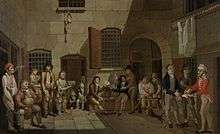
Greenway arrived in Sydney, New South Wales on the transport General Hewitt in February 1814 to serve his sentence. On board the ship was the surgeon Dr. John Harris who was to give Greenway his first private commission in the colony which involved extending his residence on his Ultimo estate.[2] Greenway first met Lachlan Macquarie in July 1814 to whom he had come recommended by Admiral Arthur Phillip.[5] During the initial meeting Macquarie sought to test Greenway by asking him to copy a design of a town hall and courthouse from a pattern book.[6] Greenway was so offended by this that he responded with a letter declaring his skills and quoting Sir William Chambers that Macquarie should utilise the opportunity for a classical design,[7] saying he would "immediately copy the drawing Your Excellency requested me to do, notwithstanding it is rather painful to my mind as a professional man to copy a building that has no claim to classical proportion and character."
Between 1816 and 1818, while still a convict, Greenway was responsible for the design and construction of the Macquarie Lighthouse on the South Head at the entrance to Port Jackson.[3] After the success of this project he was emancipated by the governor Lachlan Macquarie, and in the role of Acting Civil Architect and Assistant Engineer responsible to Captain J. M. Gill, Inspector of Public Works, went on to build many significant buildings in the new colony.
Greenway's works include Hyde Park Barracks, extensions to First Government House, the stables for a projected new Government House (condemned for their "useless magnificence" by a visiting British official, the building is now home to the Sydney Conservatorium of Music),[8] and St James' Church, Sydney, which was chosen as one of Australia's only two man-made 'treasures' by Dan Cruickshank in the BBC series Around the World in 80 Treasures.[9]
Greenway fell into disrepute when Macquarie accused him of charging high fees whilst on a government retainer, and he was dismissed by the next governor, Thomas Brisbane, in 1822.[3] He continued to follow his profession with little success.
In 1835 he was destitute, advertising in the Sydney Gazette that "Francis Howard Greenway, arising from circumstances of a singular nature is induced again to solicit the patronage of his friends and the public".[10]
Greenway died of typhoid near Newcastle, New South Wales in 1837, aged 59. The exact date of his death is not known. He is believed to have been buried in the Glebe burial ground at East Maitland on 25 September 1837, but his grave is unmarked.[1]
Posthumous tributes
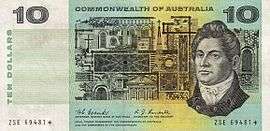
Greenway's face was shown on the first Australian decimal-currency $10 note (1966–93), making him probably the only convicted forger in the world to be honoured on a banknote.
Greenway is the eponym of a NSW Federal electorate, a suburb of Canberra, and a high school in Woodberry, a suburb of Maitland.
Francis Greenway Drive in the suburb of Cherrybrook is named in honour of Francis Greenway.
The Vaucluse home of the renowned Australian architect Leslie Wilkinson (1882–1973) was named "Greenway" in honour of Francis Greenway.
Selected list of works
The following works were either designed by Greenway, or where he had significant influence:[11]
| Structure name | Location | Period | Architectural style | Contribution | Heritage status | Image | Notes |
|---|---|---|---|---|---|---|---|
| Cadmans Cottage | The Rocks | 1815-1816 | Supervised construction |  | [12]:p.16 | ||
| Cleveland House | Surry Hills | Contribution uncertain | |||||
| Clifton Hotel and Assembly Rooms building | Supervised construction | ||||||
| First Government House, Sydney | Bridge Street, Sydney | 1810-1820 | Italianate | Extensions |
| 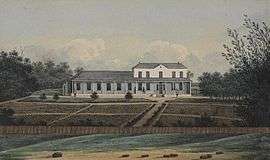 | [13][14] |
| Hobartville | Richmond | Contribution uncertain | |||||
| Hyde Park Barracks | Macquarie Street, Sydney | 1818-1819 | Architect |
| 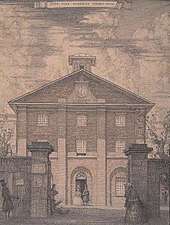 | [15][16][17] | |
| Judge's House | Sydney | Also attributed to W. Harper | [12]:p.67 | ||||
| Liverpool Technical College (formerly Liverpool Hospital) | Liverpool | ||||||
| Macquarie Lighthouse (1816–1878) | Watsons Bay | 1816-1818 | Architect | 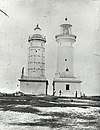 | [lower-alpha 1][18] | ||
| Obelisk | Macquarie Place | 1818 | Architect | %2C_Macquarie_Place%2C_Sydney_-_Wiki0032.jpg) | [19] | ||
| Old Government House | Parramatta | Timber portico only |
| .jpg) | [20][21][22][23] | ||
| St James' Church | Queen's Square Phillip Street, Sydney | 1820-1824 | Architect |  | [24] | ||
| St Luke's Anglican Church | Liverpool | 1818-1820 | Architect | [25] | |||
| St Matthew's Church | Windsor | Architect | 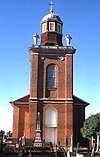 | ||||
| Supreme Court of New South Wales | Cnr King and Elizabeth Streets, Sydney | 1820–1828 |
| Architect (dismissed before completion) | 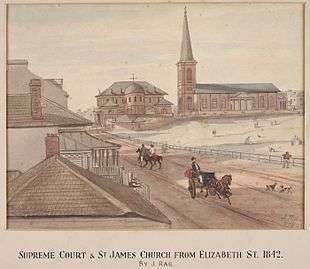 | [26] | |
| Sydney Conservatorium of Music | Macquarie Street, Sydney | Architect | [27][28] | ||||
| Windsor Court House | Windsor | Architect |
References
Notes
- The Greenway lighthouse was replaced by the James Barnet lighthouse in 1878. The former lighthouse was demolished and the latter lighthouse remains in use. The image shows the two lighthouses, side by side, in the 1880s. The Green lighthouse is on the left.[18]
Citations
- James, Clare (25 March 2008). "Francis Greenway Memorial". Maitland City Council. Archived from the original on 20 July 2011. Retrieved 12 April 2011.
- Broadbent, James; Hughes, Joy (1997). Francis Greenway Architect. Glebe, N.S.W.: Historic Houses Trust of New South Wales.
- Morton Herman, 'Greenway, Francis (1777–1837)', Australian Dictionary of Biography, Volume 1, MUP, 1966, pp 470–473. Retrieved 27 December 2008
- "Inside Newgate Prison". Discover Collections. State Library of New South Wales. Retrieved 14 February 2013.
- "Francis Greenway". Historic Houses Trust of NSW. Retrieved 14 February 2013.
- Dupain, Max; J M Freeland (1980). Francis Greenway : a celebration. North Ryde, N.S.W.: Mead & Beckett. pp. 11–12. ISBN 0-7269-2215-3.
- Howard Tanner, ed. (1981). Architects of Australia (1st ed.). Sth Melbourne: MacMillan. pp. 10–18. ISBN 0-333-29929-9.
- http://music.sydney.edu.au/about/history/
- "Around the World in 80 Treasures (TV Series) Australia to Cambodia". IMDB. Retrieved 11 October 2015.
- "Advertisement - Francis Howard Greenway". The Sydney Gazette and New South Wales Advertiser. 20 January 1835. p. 3.
- The Heritage of Australia, Macmillan Company, 1981
- Haskell, John (1997). Sydney Architecture. UNSW Press.
- "First Government House Site". New South Wales State Heritage Register. Office of Environment and Heritage. Retrieved 7 October 2017.
- "First Government House Site (Place ID 105761)". Australian Heritage Database. Department of the Environment. Retrieved 7 October 2017.
- "Heritage Council of NSW". Office of Environmental and Heritage. NSW Government. Retrieved 10 October 2015.
- "Australian Convict Sites". World Heritage Convention. United Nations. Retrieved 10 October 2015.
- "Australian Convict Sites". Department of the Environment. Australian Government. Retrieved 10 October 2015.
- "Macquarie Lighthouse Site". New South Wales State Heritage Register. Office of Environment and Heritage. H00677. Retrieved 2 June 2018.
- "Macquarie Place Including Road and Park Reserve, Obelisk, Canon, Anchor". New South Wales State Heritage Register. Office of Environment and Heritage.
- "Old Government House". New South Wales State Heritage Register. Office of Environment and Heritage. Retrieved 27 September 2017.
- "Parramatta Park and Old Government House". New South Wales State Heritage Register. Office of Environment and Heritage. Retrieved 27 September 2017.
- "Old Government House and the Government Domain, O'Connell St, Parramatta, NSW, Australia (Place ID 105957)". Australian Heritage Database. Department of the Environment. 1 August 2007. Retrieved 27 September 2017.
- "UNESCO World Heritage Centre – World Heritage Committee inscribes seven cultural sites on World Heritage List". UNESCO World Heritage Centre website. United Nations. 31 July 2010. Retrieved 17 September 2010.
- "St. James' Anglican Church". New South Wales State Heritage Register. Office of Environment and Heritage. Retrieved 17 November 2013.
- "St. Luke's Anglican Church". New South Wales State Heritage Register. Office of Environment and Heritage. Retrieved 5 December 2016.
- "Sydney Supreme Court House (Old Court House)". New South Wales State Heritage Register. Office of Environment and Heritage. H00800. Retrieved 2 June 2018.
- "Conservatorium of Music". New South Wales State Heritage Register. Office of Environment and Heritage. Retrieved 25 February 2017.
- "Conservatorium of Music Including Interior and Grounds". New South Wales State Heritage Register. Office of Environment and Heritage. Retrieved 7 October 2017.
Sources
- Serle, Percival (1949). "Greenway, Francis". Dictionary of Australian Biography. Sydney: Angus and Robertson.
- Dictionary of Australian Artists Online
- Francis Greenway Drive
External links
